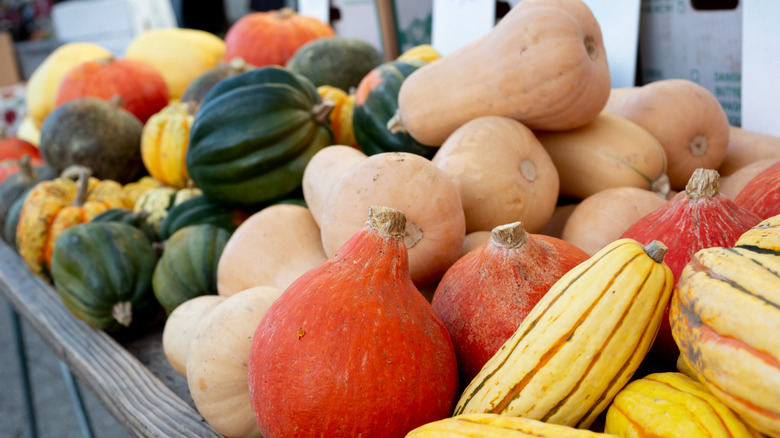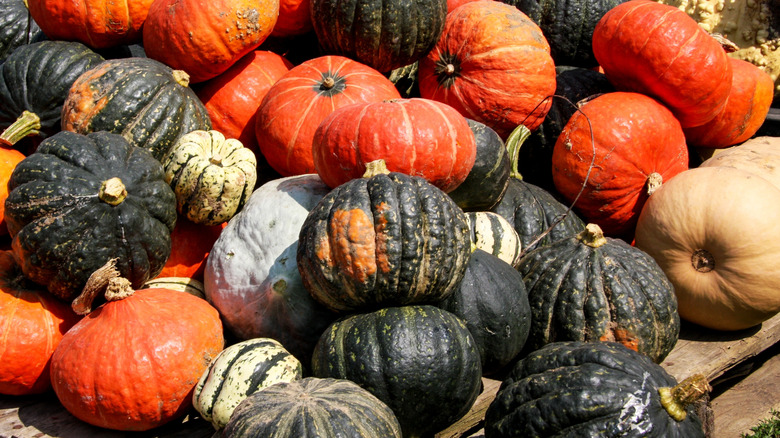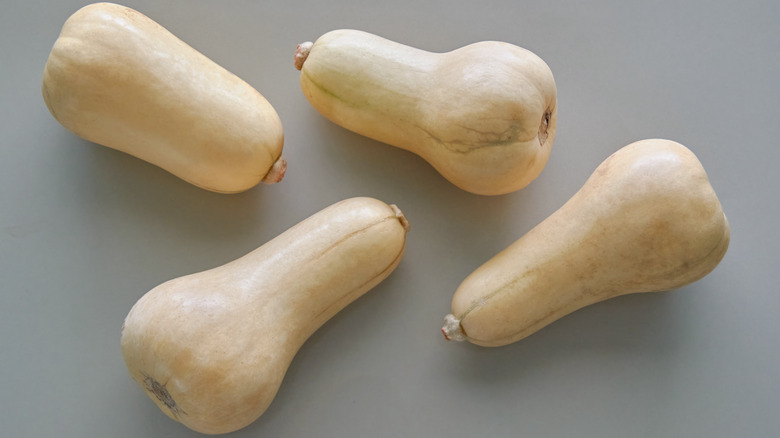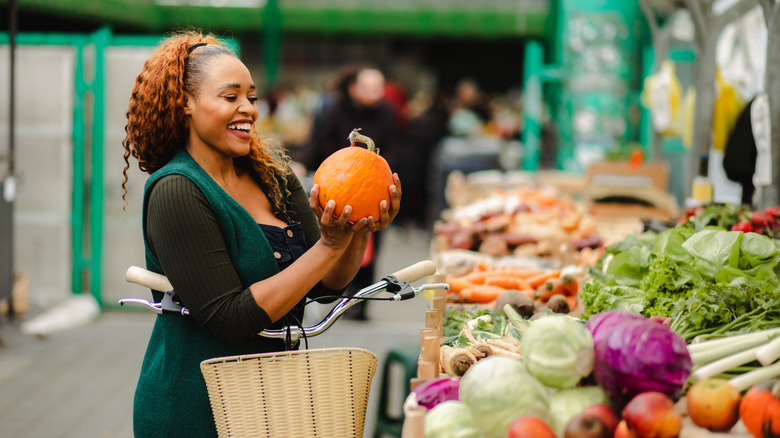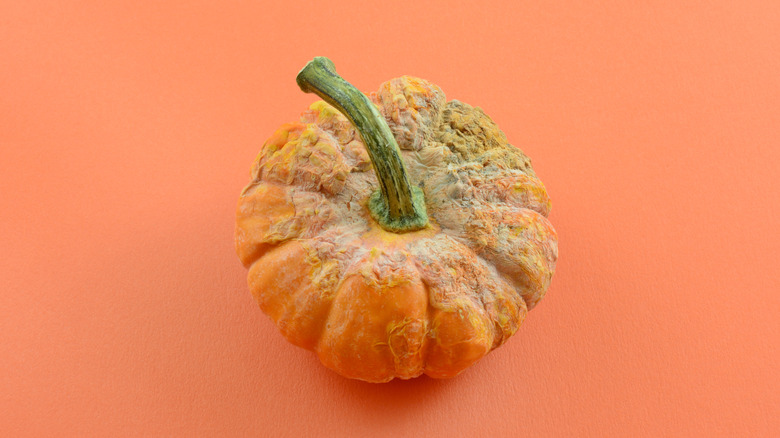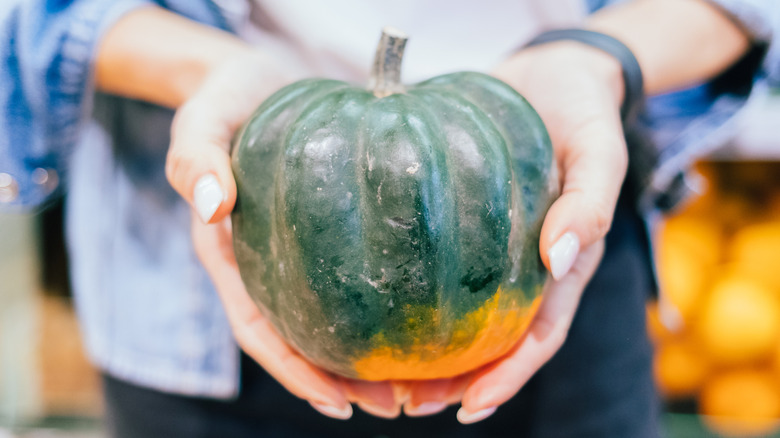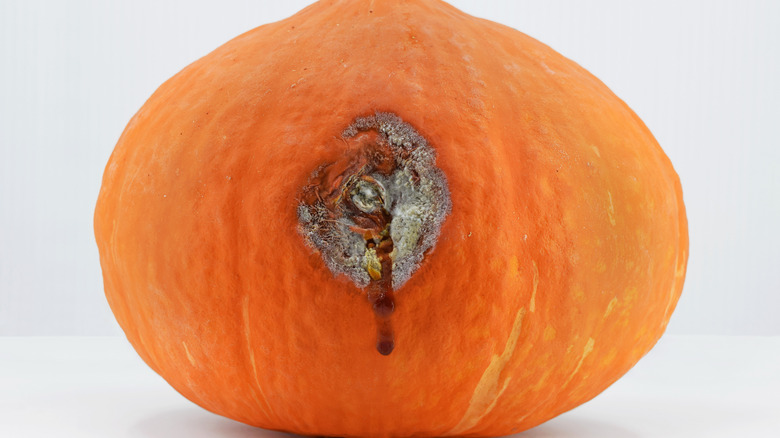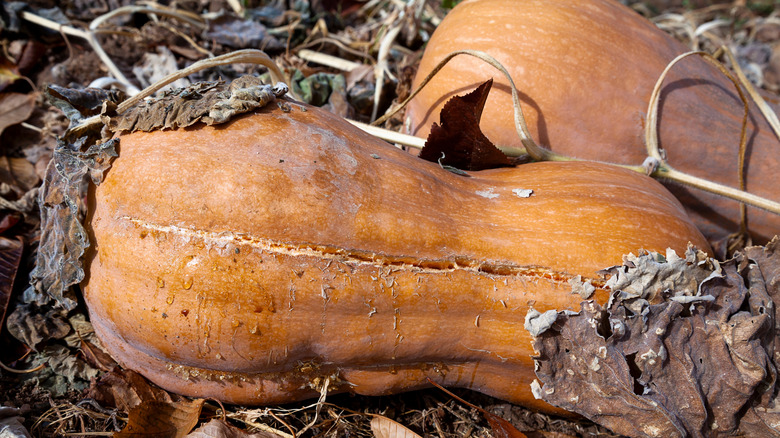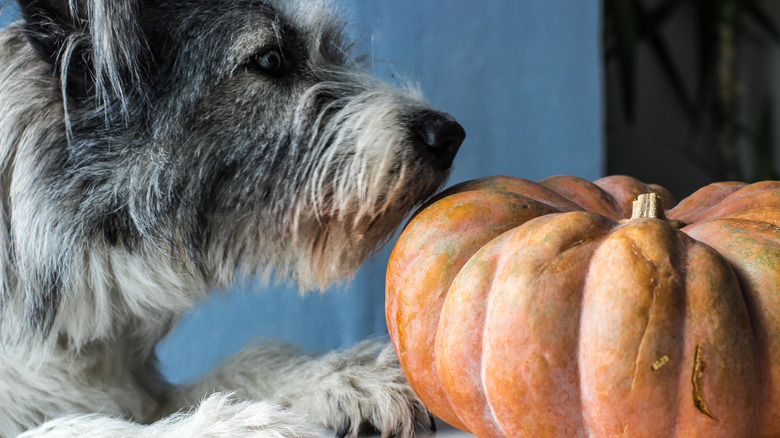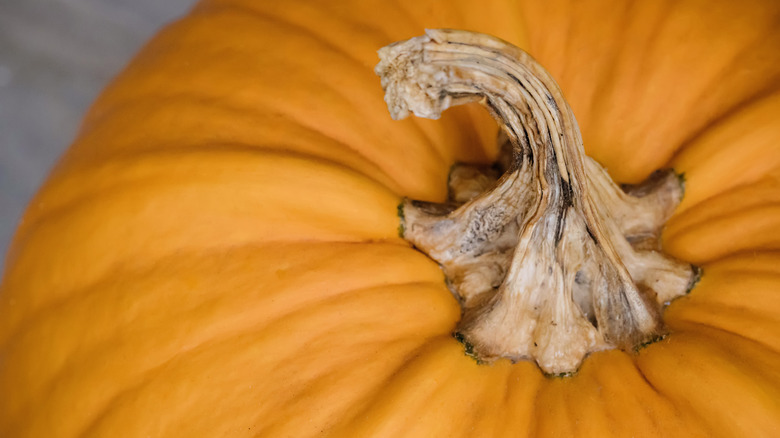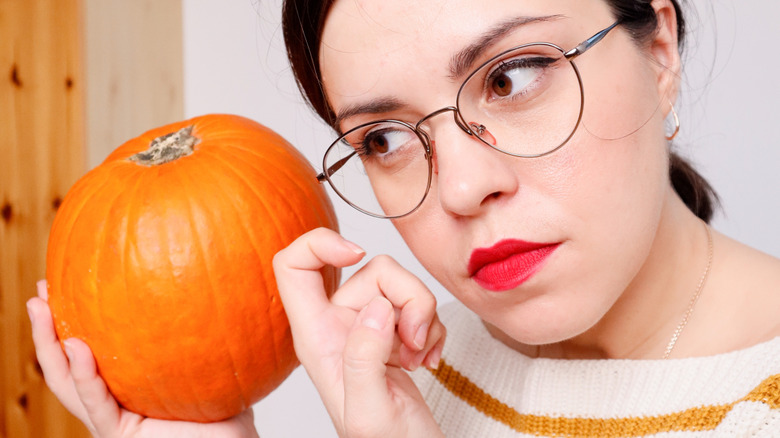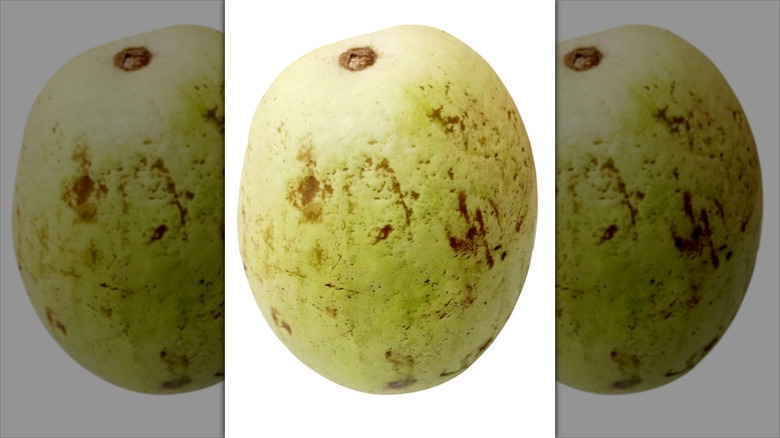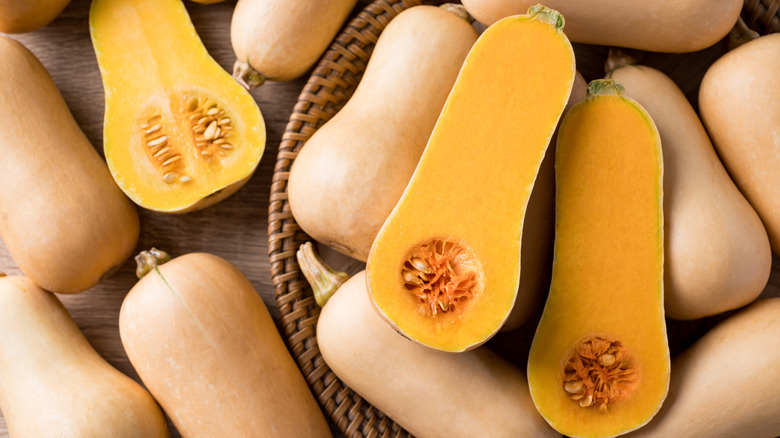12 Tips For Picking The Best, Freshest Squash At The Grocery Store
In the winter months, squash are a kitchen staple for many. They're forgiving to cook, long-lasting in the pantry, and capable of being made into everything from soups and sauces to desserts. But that can lull you into thinking any squash will do. Truth is, it won't. Some squash just aren't up to scratch. Picking a great squash at the store saves you time, money, and disappointment. No one wants a dry butternut or an overly fibrous kabocha.
Think of squash selection like choosing apples or pears. Different varieties have different ideal appearances, but a few simple checks will point you to the best, freshest specimens. Across varieties, you'll be looking for the same signals. The correct color for that type, the right skin appearance, and the correct weight. Of course, it can take a little while to learn how to read a squash right, but once you've got it down, you'll never pick a bad one again.
We'll go through the quick checks that separate the squash you'll actually want to cook from the ones you'll end up tossing. Just a few extra seconds, a little curiosity, and some attention to detail are all you need. Follow our advice and you'll learn how to pick the best squash on offer.
1. Look carefully at the color of the squash — and know it should be different for every variety
Color is among the quickest cues to a squash ripeness, but it's only useful if you know what that variety should look like. There are many types of squash, all of which look different. A good butternut, for example, should be a warm, even tan or dark amber. An acorn squash should be deep green with orange or yellow patches, while delicata is cream-colored with green stripes. For acorn and delicata, you should see some green, but if a butternut is streaked with green, it was picked too soon. So, there's no simple answer that fits every squash. When in doubt, read the label or compare it to other specimens on the display. A single oddball in a bin of uniform color is worth skipping.
Don't panic over natural mottling. Many squash develop harmless speckles that won't ruin the interior. What to avoid are large areas of faded, pale discoloration (which can indicate underripeness or prolonged storage), or rusty, orange patches on varieties that should be uniformly dark; those can be signs of decay starting beneath the skin. If you're buying by sight alone, pick two or three squash of the same variety and choose the one with the richest, most even color. It's a quick habit that will markedly increase the odds of bringing home squash with good texture and sweetness.
2. Select a squash with matte skin
You might think you should be looking for a squash that's shiny like an apple. But, actually, a dull, matte finish is often the easiest visual shorthand for a mature, cured winter squash. So, if it's gleaming like it's been polished, leave it in the produce aisle.
Squash can be shiny while they're growing, but a matte finish is a sign that they've become ripe enough to pick. What's more, during curing (the time spent drying after harvest), the skin hardens and loses any remnant of the youthful sheen of newly picked fruit. That dullness usually means the rind is thick enough to protect the flesh, and the squash will keep for months. By contrast, an unnaturally glossy squash can be underripe or freshly harvested and not fully cured.
As a rule, matte equals mature. You just need to take a look at the squash selection at your local store, and you can tell if any are far from ripe. Run your fingers over the skin: A light powdery residue or "bloom" is fine and normal, whereas tackiness or a slick feel is not. Also watch for an overly powdery appearance coupled with soft spots underneath — that combination can suggest the outer rind is breaking down.
3. Pick a firm squash
It's easy to test the firmness of a squash in the produce aisle — and it will tell you a lot about it. Ideally you want a squash that feels solid through and through. Press gently with a thumb near the stem and at the blossom end; there should be no give at all. If you can depress the skin even a little, put it back.
That said, "firm" isn't the same as rock hard. Some varieties, like delicata, have thinner skins that might feel slightly less armored than a kabocha or butternut. However, even the less robust varieties should be unyielding when you press. If you're buying for long storage, favor the firmest specimen you can find. A squash that's firm now will hold its texture and sweetness in the pantry.
Softness can mean it's begun to rot, or it simply never finished curing after harvest. Poor curing leaves a squash with a thinner, less protective skin and higher internal moisture, which makes it far more prone to both decay and a bland, watery texture. Curing lets the rind harden, small nicks dry and knit over, and the squash lose excess surface moisture; it also helps stabilize sugars and extends shelf life. In short, a properly cured squash should feel dense and dry to the touch. If it doesn't, you're taking home something that will either spoil sooner or won't be as good to eat.
4. Avoid mold
Mold on winter squash is a clear red flag, and one you shouldn't ignore in the produce aisle. Because the rind is thick, you'll often see mold first as a fuzzy patch around the stem or a dark, slightly sunken spot near the blossom end. Even if the rest of the squash looks fine, mold frequently travels beneath the skin where you can't see it.
If you spot small, superficial mold on a very hard-skinned squash, it's sometimes possible to cut the affected area away with a generous margin and use the rest immediately. But that makes sense only for squash you already have. When you're picking one up at the store, avoid even the smallest amount of mold.
To reduce the chance of mold at home, store squash in a cool, dry, well-ventilated place — avoid keeping it anywhere damp or in crowded piles where moisture builds. Inspect it before you buy and again when you get home. Catching a problem early can save you from an unpleasant surprise on the cutting board. When in doubt about a dark spot or a bit of fuzz, leave it in the produce aisle. Only take home a squash you're sure about.
5. Choose a squash that's heavy for its size
You might think you know everything you need to know about winter squash, but weight is one of the simplest, most revealing tests you can do at the grocery store. A heavy squash for its size means dense, moist flesh, which is exactly what you want whether you're roasting wedges, mashing, or pureeing. Two identical-looking squashes can feel worlds apart; the denser one will give you more usable cooked flesh, better texture, and more pronounced natural sweetness. If it's light, it can either signify the squash didn't ripen enough before harvest, or it's past its best and has started drying out, neither of which you want.
Lift a couple of the same variety and compare. A little extra heft translates directly into richer, creamier results, so this isn't a metric to be ignored. Keep in mind that weight combines with other checks: A heavy squash that's also firm and matte-skinned is a top pick. Conversely, a light squash that seems thin for its size often has dried-out flesh, large seed cavities, or internal pithiness that shows up after cooking as stringiness or blandness. Some varieties may weigh more than others, but the "heavy for size" rule is a reliable, quick check for winter squash.
6. Avoid soft spots
Soft spots are often the first physical sign of real trouble. When you press and the rind gives even a little, that area is vulnerable. It can harbor bacteria, attract mold, and turn into a mushy pocket once you cook the squash. Do a systematic check by pressing gently with your thumb near the stem, the middle, and the blossom end. Then, run your hands over the curves to feel for dips or spongy patches. Look for discoloration around any tender area — brown or darker tones beneath the skin are another warning.
Small, very localized bruises on a thick-skinned squash can sometimes be trimmed away at home if the rest of the fruit is firm and clean, but large or multiple soft spots mean the whole squash is compromised and should be avoided. When you're buying a squash, you want the best in the bunch, so don't settle for second best. A uniformly firm squash will store for longer and will be nicer when cooked. It gives you consistent texture, better roasting color, and the confidence that the flesh inside will be sweet and smooth rather than watery or stringy.
7. Watch out for cracks or cuts
Cracks, splits, and fresh cuts are more than cosmetic. Moisture, bacteria, and mold can get under the rind and start the squash's slow decline. Many cracks happen in the field, during transport, or in grocery bins. A scar that's dry and healed doesn't look great, but it's often harmless. It can be caused by something as simple as the vine or leaves rubbing against the squash as it grows. A fresh cut, though, especially one that exposes the flesh inside, is a deal-breaker for storage and usually for immediate use too, because that exposed tissue will rot quickly.
When you're choosing, check the squash carefully. Look for split seams around the stem or along the bulb — those are often weak points. Check the blossom end, where impacts commonly cause cracks. Also, beware of thin, papery splits that look dry on the surface but gape open at certain angles. All these are signs you should leave the squash in the store.
If you do buy a squash with a small, well-healed scar, that's fine. Store it in a cool, dry, ventilated spot and keep an eye on it, using it within weeks rather than months. But if the rind is sliced, leaking, or the cut shows flesh, don't gamble. Just pass it up. Choosing an unbroken, intact rind is the easiest way to guarantee shelf life and clean, sweet flesh when you finally cook it.
8. Choose a squash with no or minimal odor
There are ways to upgrade squash for more flavor, but you have to choose a ripe one first. Scent is a surprisingly honest signal of a fresh squash. A healthy winter squash should register as mostly neutral at the stem and blossom ends. There may be a faint, earthy note or a gentle hay-like perfume on some varieties, but not much more. Any sharp, musty, fermented, sour, or rotten smell means decomposition has started. Because the rind hides what's inside, a bad odor can be the quickest clue that the interior is compromised, even if the squash looks okay at first glance.
When you're in the produce aisle, give a quick sniff where the stem meets the fruit and around any creases. A tiny hint of sweetness or a dry, vegetal smell is normal, especially with varieties like kabocha or butternut, but anything that smells like alcohol, vinegar, or rotting vegetation is a red flag. Trust your instincts: If a squash smells off to you, it probably is. If you cut into a squash and an unpleasant aroma hits you, don't try to rescue it — simply discard it. Fresh squash should smell faint and clean, not heady or fermented.
9. Check out the stem
The stem tells a surprisingly detailed story about a squash's harvest and handling. A sturdy, intact stem usually means the squash was cut cleanly at harvest and allowed to cure. Stem tissue that's tan, dry, and woody indicates proper maturation. A green, flexible stem that may be leaking sap shows that the squash was harvested too early or wasn't cured properly. Equally, a missing or ragged stem is a vulnerability. Once the protective stem is gone, the rind at that spot is more likely to develop mold, rot, or a soft spot.
When you inspect stems, look for firmness and dryness. It should look a bit gnarled and woody. Check for mold or softness around the stem, as a fuzzy growth or mushy connection is a clear sign of trouble. Wiggle the stem gently; if it's loose or the surrounding rind gives, skip that squash. Some varieties naturally have short, stubby stems or ornamental twisty stems; those are normal, but the base should be solid and well-attached.
Leaving the stem on until you're ready to cook also helps. It means that you're not opening up a weak spot through which bacteria can enter and decay can start. In short, pick a specimen with an attached, woody stem and leave it be until it's time to cook, whether you're making roasted squash, soup, or anything else.
10. Give it a tap
Tapping a squash is a great way to find out if it's fresh and ripe. Gently rap the widest part of the rind once or twice and listen. A ripe winter squash often responds with a clear, somewhat hollow sound. That tells you the flesh inside is dense, and the seed cavity isn't waterlogged or rotting. A dull, flat thud is less encouraging. It can mean it's either over-ripe or under-ripe. Tapping a squash won't replace the other checks you've already done, but it's a neat way to confirm what your hands and eyes have suggested.
You don't need to bang on the squash; a gentle tap is plenty. Bashing it too hard could bruise or damage it. And don't use it on a suspicious-looking squash that already has cracks, mold, or soft spots — those signs trump any hollow sound. Use the tap as a final, quick sensory check. When a firm, matte, heavy squash also gives a bright, hollow note, you've probably found one that will roast sweetly and keep well. If the sound is flat or uneven, move on.
11. Avoid bruised squashes
Squashes are among the fruits and vegetables that last the longest, but only if you choose a good one. Avoid any with bruises if you want them to be good to store for long periods. A bruise will feel slightly soft or spongy under the rind and often shows darker, damp-looking discoloration. A single, small bruise on an otherwise firm squash can sometimes be trimmed out and used quickly, but multiple bruises or large dark patches mean the squash may already be rotten inside. Of course, given the chance, you should avoid specimens with even the smallest of bruises.
Not all surface damage is equal, and learning the difference between a healed scar and a bruise will save you from needlessly rejecting perfectly good squash. Superficial scars that look like dried, corky patches are just cosmetic. They occur in the field from rubbing, sun exposure, or minor scrapes, and after curing, they form a protective callus that doesn't penetrate deeply. Those are fine. They aren't a sign of further issues in the same way bruises are.
12. Pick a squash with smooth skin
Smooth skin usually means the rind formed evenly and the squash was handled gently, which are both desirable traits for storage and cooking. A smooth, unbroken surface makes it harder for microbes to colonize, easier to clean, and less likely to hide small cuts or soft spots.
That said, smooth is relative. Some varieties are naturally bumpy or ribbed. In certain heirloom squashes or warted ornamental types, those textures are normal. Judge smoothness against what's typical for that variety. For example, a butternut's skin should be firm and mostly even, whereas a hubbard will have a coarse, slightly knobbly surface by design. What you want to avoid are rinds that feel flaky, crumbly, or that have thin, peeling patches.
Smooth skin also matters for prep: It's easier to peel, slices cook evenly, and the appearance after roasting is neater. Combine this check with weight, firmness, and stem condition, and you'll consistently bring home squash that are fresh and ripe.
